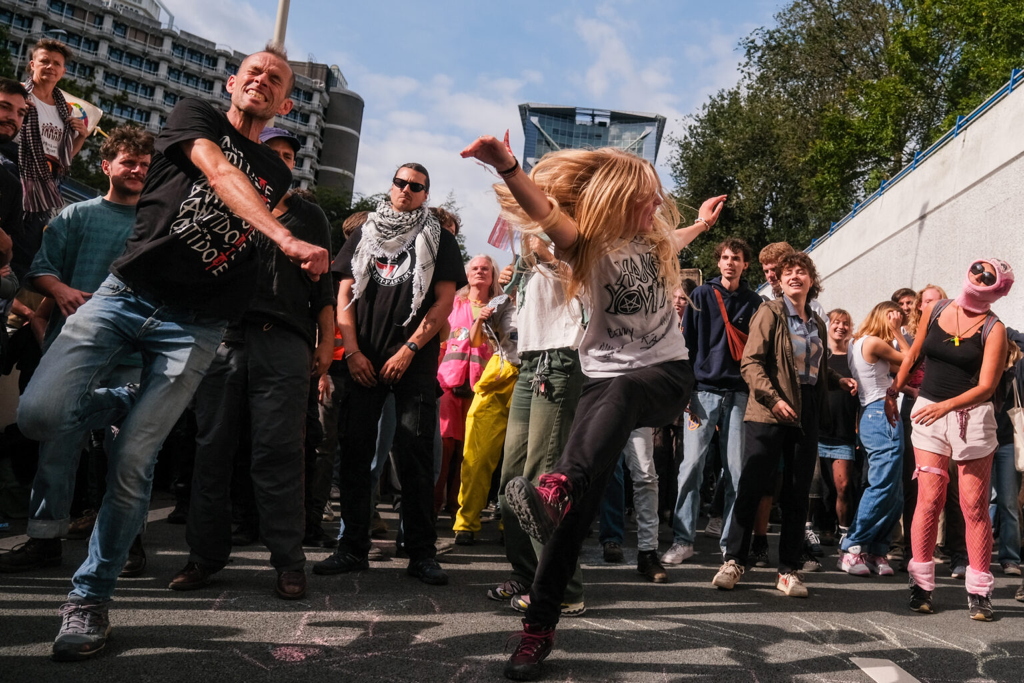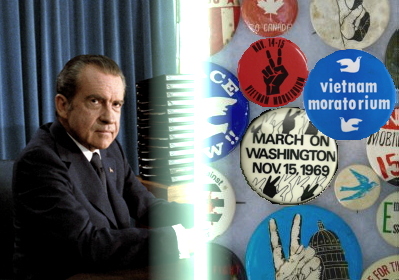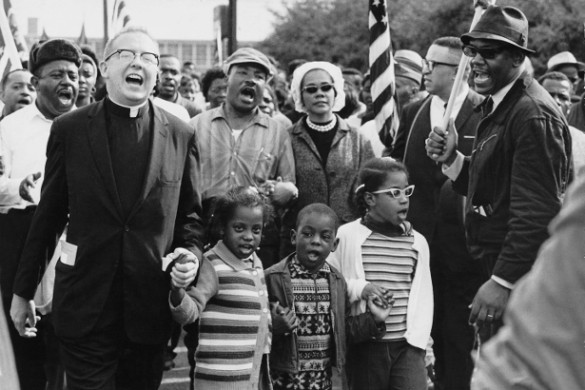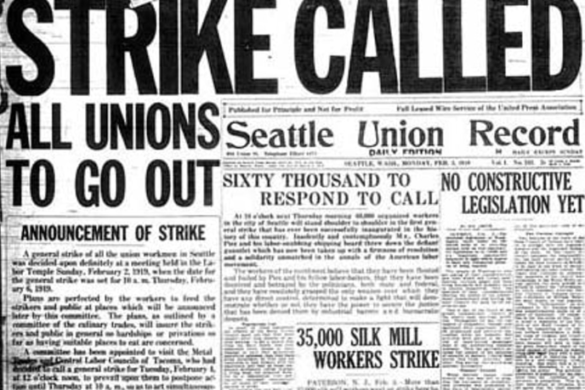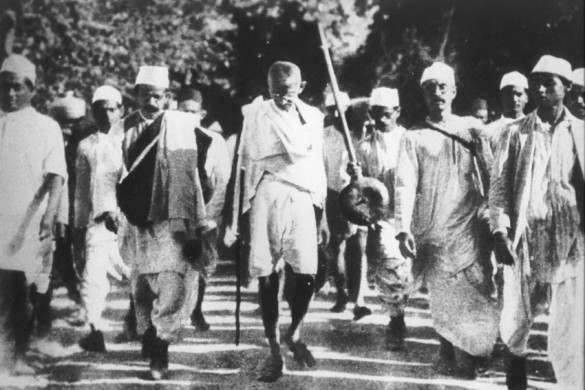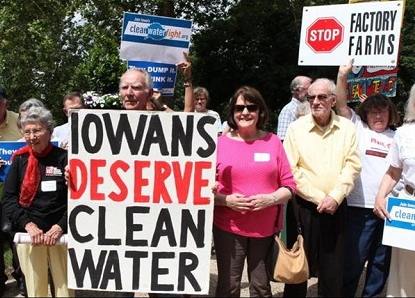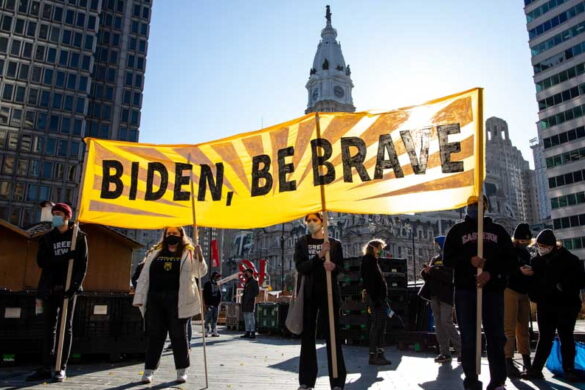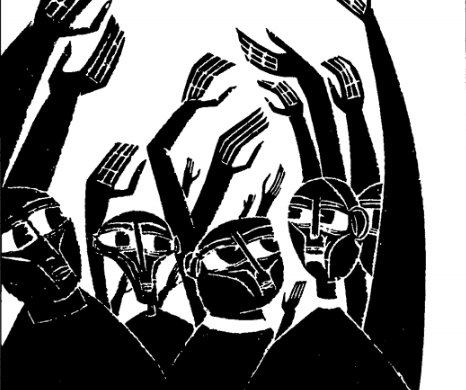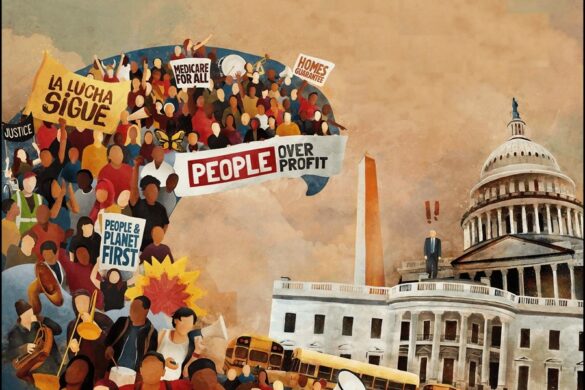An innovative Extinction Rebellion campaign to end to fossil fuel subsidies in the Netherlands offers key lessons for the next wave of the climate movement.
By Paul Engler
(Published in Waging Nonviolence and Truthout)
Creating a trigger event and a moment of the whirlwind — a period in which social movements capture the political spotlight in a country in a major way and shift the terms of public debate — is a rare and important accomplishment. The initial rounds of Extinction Rebellion actions in the U.K. in 2018 and Sunrise’s public breakthrough in the United States the same year, as well as the emergence of Fridays for Future in 2019, each made significant waves.
However, since then there have been limited moments in which climate activism has resonated as profoundly and altered public opinion. Movements are now actively trying to experiment and innovate in order to create a new wave of whirlwinds — and their success in figuring this out will be critical for whether social movements can win in the future.
In the fall of 2023, activists with Extinction Rebellion Netherlands, or XR NL, were able to create an important whirlwind moment that may serve as a model for the next wave.
After a series of blockades that escalated over the course of two years, they reached a period in September and October 2023 during which daily protests became a media sensation and drew mass participation, with estimates of up to 25,000 people joining on the biggest day of protest. The campaign saw an extraordinary level of collective sacrifice, with as many as 2,500 people being arrested in a single day and a total of more than 6,000 arrests occurring over an eight-month period.
Discussion of the campaign’s demand of ending public subsidies for the fossil fuel industry became an important topic in mainstream Dutch politics. The campaign succeeded in generating widespread popular support for their issue, whereas many other activists using similar tactics have not been able to achieve such gains with the public.
So what, then, did the Dutch campaign do differently? And what can we learn from their efforts?
I conducted interviews with four top organizers of the campaign to explore these questions. From these conversations, three key lessons emerge.
* * * * *
The importance of a great symbolic demand
The first lesson is the importance of finding and elevating a symbolically loaded demand that can resonate widely with ordinary people.
For building mass protests, the technical aspects of how an activist demand might play out when negotiated in the political system are less important than the ability of the public to understand and relate with the cause, and therefore become motivated to join in pressuring public officials to respond decisively. Later on, inside-game players and organizations within other parts of the social movement ecology will be critical in sorting out the instrumental details of the specific proposals adopted to address the issue. But organizers in the mass protest sphere — whose job is to reshape the political terrain and thereby alter the limits of what is considered politically practical and necessary — do best to focus on their demand’s popular resonance.
In the case of XR NL, organizers were savvy in identifying public subsidies for fossil fuels as an issue that could galvanize the public.
A report published in June 2020 by the environmental advocacy group Milieudefensie indicated that these subsidies cost the Dutch public an average of 4.9 billion euros (or $5.4 billion) per year. XR NL’s campaign was successful in moving this from being an obscure item that few people understood to being a central topic of public debate. As writer and former XR organizer Douglas Rogers previously reported for Waging Nonviolence, “This was a niche issue at the time” that the group launched its campaign in 2020. Three years later, it had decisively entered the mainstream.
“No politician would ever be able to raise the profile of something like this,” XR NL spokesperson Chris Julien told me. “These actions became a headline political theme, and politicians started to say, ‘Yeah, we want to end fossil subsidies.’” The importance of the topic, he argued, “really got absorbed by the political class.”
The issue was easily understood by most people. Lucas Winnips, one of the core organizers, told me that when they began, the estimated amount of fossil fuel subsidies “was already more than the climate budget at the time. So people were immediately outraged when they heard about it, and there was a lot of enthusiasm to join.” He added, “it was just totally clear that you should stop fossil fuel subsidies in the time of climate crisis.”
Julien said it helped tremendously that the demand was “very commonsensical” and that the core message was “super simple.” He added, “I think everybody felt a sense of empowerment and agency because the demand was just right.”
Unlike with other climate related demands such as banning private jets or opposing private financing of fossil fuel expansion, people could easily relate with the idea that taxpayer money was being wasted on something they did not believe in. XR NL organizer Emma Nantermoz told me that listeners responded positively when organizers highlighted how much fossil fuel subsidies cost the public. As she put it, the campaigners could show that “this money could be spent, for example, on free public transport… or a higher minimum salary. … You could spend that money much better, in a way that could benefit everyone.” It was a message that resonated with many people outside of usual leftist, activist and youth circles.
Julien believes that the spokespeople they used to represent the demand also reinforced its common-sense appeal. “The people we encouraged to go in front of the camera were all super reasonable — firm and clear on the science of what needs to be done, but otherwise very ‘mom and pop,’” he said. Having a combination of people who were “super everyday” in their overall presentation and profile but radical enough in their politics to join XR NL’s campaign of civil disobedience “really grew the movement,” he contended.
Over time, as activists focused increasing attention on the issue, it created opportunities for new research and inquiries into the issue to become public flashpoints. In particular, a series of successive studies released during the campaign showed that the initial estimate of the amount of subsidies being received by the fossil fuel industry had, in fact, been dramatically understated. With each new investigation, the true amount of public funds devoted to fossil fuel subsidies was revealed to be much higher than previously estimated, spurring greater public outrage and feeding activists’ momentum.
A third significant lesson from the A12 efforts relates to how leadership functioned in the campaign. The campaign followed a distributed leadership model that allowed for decentralization but rejected pure horizontalism.
Decisions about launching and managing the A12 blockades were not made by a centralized committee of XR NL. Rather, it arose from a model in which core teams of activists are given autonomy to design their own campaigns, and participants are allowed to democratically “vote with their feet” in deciding which drives they want to participate in. In this model, those who are successful in designing and leading specific campaigns earn the right to exercise considerable leadership as those campaigns unfold. At the same time, they cannot claim to represent the whole of the organization, and others are free to launch projects of their own.
This leadership model can be controversial, especially among advocates of general assemblies, consensus decision-making, and pure horizontalism. However, it has distinct advantages and can be seen as a way to recognize the initiative and intensive commitment of a core team, while also allowing widespread participation and fueling grassroots initiative to generate other projects.
The primary direction of the A12 campaign was carried out by a core team of approximately a half dozen individuals. These leaders were each given responsibility over key areas of the campaign and delegated work within their area to incoming volunteers. Nantermoz remarked: “The balance between decentralization and a core-driven control structure is, I think, what made the A12 strong and different from most XR campaigns. We had this approach both within the campaign and with the rest of the movement.” Douglas Rogers noted that international observers, such as Marina Hagen-Canaval, a spokesperson for Last Generation Austria, attribute “a lot of significance to an XR NL decision to designate a core team with a mandate for organizing the A12 actions, as a way of streamlining decisions.”
Core team member Nantermoz explained that the core “delegated a lot to rebels,” a term the campaign used to refer to committed activists, who had specific roles and responsibilities, and “also the freedom to do it in their own way.” Hofstede added: “One person was doing everything around posters and flyers and stuff like that. So the other five of us had nothing to do with that… Another person was involved with action trainings and getting those organized.” Being responsible for a given area, however, could also mean getting others involved, she notes. “We all had our own little parts and made sure that it [all] happened, not by doing it all by ourselves, but by making sure it happens.”
Nantermoz contended that, while not free of disagreement, the core group benefited from complementary qualities and a shared vision. “We managed to balance each other out,” she said. “And that was something that was really successful; there was a lot of trust.” The fact that they didn’t have to check up on one another allowed them to keep planning meetings short. “We only spoke to each other one hour a week,” she recalled, “and the rest of the week, every one of us would do our own thing.”
Importantly, the core team structure allowed the A12 campaign to stick to their one key demand and maintain a focused message, even though there was pressure to add on other items to what they were fighting for. Tessel Hofstede attributed much of the campaign’s success to their ability to “always bring [the focus] back to one simple demand that a lot of people can agree with.” Nantermoz echoed these remarks: “If you just focus on one thing,” she argued, “it’s a lot more likely that [supporters] will stick to it.”
Over time, internal debates emerged in the movement about the scope of the core team’s mandate to lead on the A12 campaign. Nantermoz noted that the core team “did what we thought was necessary. And some people within the movement didn’t like that, and definitely thought we had too much power.” In particular, “During the summer [of 2023], there were a lot of meetings about this that were quite intense,” she said, “where you would talk for hours about mandates and organizing and just not go anywhere.”
In the campaign’s period of rest and recovery after the fall 2023 climax, most of the core team members decided to step back, allowing new leadership to take over the A12 efforts. Several of the previous core organizers decided instead to move on to launching new campaigns, including one focused on the Dutch financial institution ING and its funding of fossil fuel projects.
* * * * *
After the whirlwind
The combination of a strong demand, a successful plan of escalation, and effective leadership allowed the A12 blockades to become landmark actions. Lucas Winnips told Democracy Now! in October 2023: “During this campaign, we achieved a transformation, I think, of Dutch society, with three-quarters of the people now wanting a phaseout of fossil fuel subsidies, and even a third of the people wanting an immediate stop on fossil fuel subsidies.”
Anytime a moment of the whirlwind occurs, its impact must be tracked over the long term. The shifting of the political landscape in a given area can have many implications, not just around a single policy demand, but in terms of how it affects the social movement ecosystem, how climate advances are pursued within various pillars of society, and how wins in one place can reverberate in other localities and other countries. For this reason, it will be some time before the full implications of the A12 whirlwind are understood.
Gains by the populist right in November 2023 elections and the ultimate formation of a right-wing coalition government in the Netherlands in the summer of 2024 has created uncertainty about how Dutch policy around fossil fuel subsidies will play out. Yet because of high public support for the demand of ending subsidies, the right did not overtly campaign against it, focusing instead on issues such as immigration. Although activists are critical of their government for posturing rather than taking concrete action, the Netherlands positioned itself at the COP28 climate summit in Dubai last December as the leader of a coalition of nations committed to phasing out fossil fuel subsidies.
In 2024, protests on the A12 highway have resumed. These included a mass action in April in which 400 people were arrested, among them prominent Swedish activist Greta Thunberg. Simultaneous actions in more than a half dozen countries across Europe took place that same day, with organizers announcing a coordinated international campaign to push their respective governments to move on the subsidies issue.
Julien believes that, in addition to being a demand with widespread appeal, it is also one with radical implications. “If you’re a bit more revolutionary in your attitude,” he explained, “You’re thinking, ‘I’m really sticking it to these industries, because they’re all screwed without the subsidies. They have no business case.’” By pursuing the end of public support for the fossil fuel industry, the A12 campaign showed an important path toward bigger climate victories. Or, as Julien puts it: “If you can flip this, then the whole system starts to move.”
Research assistance for this article provided by Raina Lipsitz. Photo credit: @maarten.photomic via Instagram

